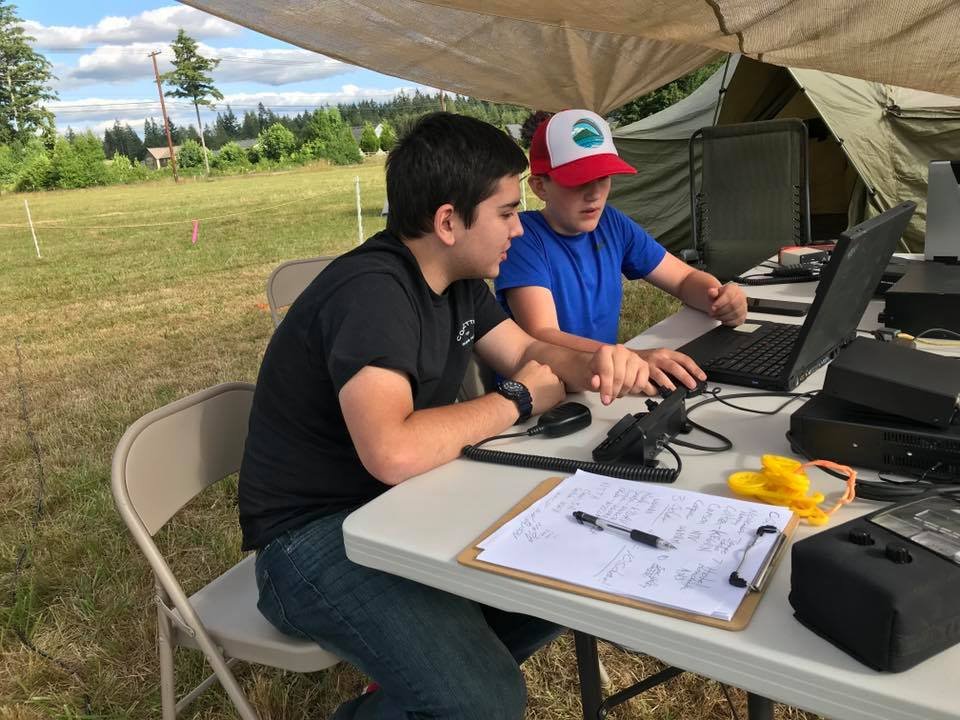Information For new Hams

2018 ARRL Field Day! Skylar, K7STT, and Noah, who is still working on his license, took advantage of the great weather and worked together to log contacts!
You studied, you passed the test, you got your ham license! Now what?
Helpful links:
Also read the Welcome Pamphlet located in the Articles section of this website.
These are important things to help you get started. Most experienced hams are so used to this info that they often don't realize that new hams may struggle to find this basic info.
The three top items needed by new Hams are VHF/UHF simplex frequencies, a list of local repeaters, and a list of local nets. Also there should be some amount of introduction given to new Hams for these topics. Unfortunately, new Hams are rarely provided with these. This page is intended to take a small step toward bridging that gap.
Simplex frequencies...
sim·plex adjective; technical adjective: simplex
- composed of or characterized by a single part or structure.
Simplex communications is just you and the other ham, one on one, talking directly to each other over the radio without the aid of a repeater.
Simplex frequencies can vary by area. The best bet is to search for the band plan for your area. The band plan for Western Washington is maintained by WWARA.(pdf) Look for "Simplex" in each band.
For example, looking at the 2-meter band, you'll find that 146.5200-146.5800 and 147.5200-147.6000 are listed as simplex frequency ranges. Great, now that only leaves you to determine the spacing between the channels.
Unfortunately, WWARA isn't very good at consistently indicating the channel spacing. There are a couple of clues, however.
The first is that the band plan does indicate that spacing between repeater channels is 20khz, so it's likely that the same spacing would apply to simplex.
The second indicator is that the simplex frequency ranges end in nice pairs of zeros. There are no fives in there. So that would tend to reinforce the idea of 20khz spacing. Unfortunately, this author has never actually found anything that specifically makes it clear, so we probably have to just assume that the spacing on 2-meters is 20khz.
To make things easier for you, here are the FM Voice simplex frequencies from the current (2016) WWARA Band Plan.
Go ahead and program these into your radio, for whichever of these bands your radio supports.
| 146.520 | 146.540 | 146.560 | ||
| 146.580 | 147.520 | 147.540 | ||
| 147.560 | 147.580 | 147.600 |
Note: It's important for you to learn how to program both simplex frequencies and repeaters into your radio without the use of the manual or Youtube.
While it's ok for you to use software such as Chirp to program your radio, you'll need to take the time at some point to teach yourself how to program your radio manually and to practice doing so. If you were ever called upon to join and assist on a Net, it's likely that you won't have your computer, radio manual or both.
Repeaters in your area...
Well, you'll need the list of repeaters in your area, and here in Western Washington State, the Mike and Key Amateur Radio Club in Renton does a great job of maintaining a list of repeaters.
Unless specifically indicated otherwise, repeaters are open for public use by licensed amateurs.
When using repeaters, remember to wait a second or two after keying your mic before you begin to speak.
Local Nets...
Mike And Key Amateur Radio club also maintains a list of nets.
Most nets are held via repeaters, (unless the net is listed as 'simplex') so you'll need to set your radio appropriately for whichever repeater the net is using. Go ahead and listen in. They can be quite educational. You'll notice that most nets will ask for guest check-ins. That's you! Once you've heard enough to know how to check in, and if you feel that you're close enough to the net or repeater to be heard, give it a try.
HF
The realm of HF, 3-30MHz, opens up the world for you. ARRL has a couple of slideshows introducing the world of HF at http://www.arrl.org/tutorials